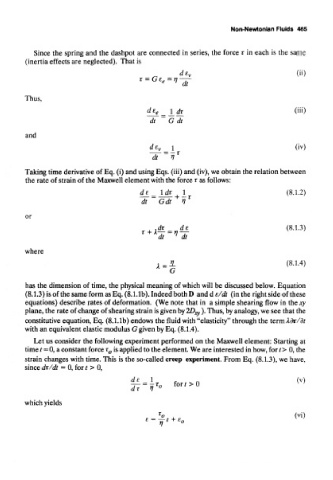Page 481 - Introduction to Continuum Mechanics
P. 481
Non-Newtonian Fluids 465
Since the spring and the dashpot are connected in series, the force r in each is the same
(inertia effects are neglected). That is
Thus,
and
Taking time derivative of Eq. (i) and using Eqs. (iii) and (iv), we obtain the relation between
the rate of strain of the Maxwell element with the force r as follows:
or
where
has the dimension of time, the physical meaning of which will be discussed below. Equation
(8.1.3) is of the same form as Eq. (S.l.lb). Indeed both D and d e/dt (in the right side of these
equations) describe rates of deformation. (We note that in a simple shearing flow in the xy
plane, the rate of change of shearing strain is given by 2Dyy). Thus, by analogy, we see that the
constitutive equation, Eq. (S.l.lb) endows the fluid with "elasticity" through the term Adr/a?
with an equivalent elastic modulus G given by Eq. (8.1.4).
Let us consider the following experiment performed on the Maxwell element: Starting at
time t = 0, a constant force T O is applied to the element. We are interested in how, for t > 0, the
strain changes with time. This is the so-called creep experiment. From Eq. (8.1.3), we have,
since dr/dt = 0, for t > 0,
which yields

